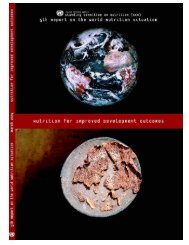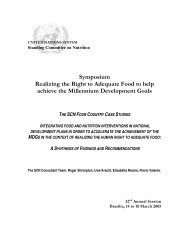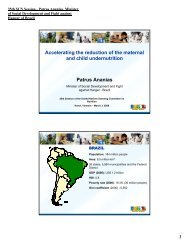Universal Salt Iodization (USI) - FTP Directory Listing
Universal Salt Iodization (USI) - FTP Directory Listing
Universal Salt Iodization (USI) - FTP Directory Listing
- No tags were found...
You also want an ePaper? Increase the reach of your titles
YUMPU automatically turns print PDFs into web optimized ePapers that Google loves.
www.unsystem.org/scn 59Programme NewsEfforts to fast track <strong>Universal</strong> <strong>Salt</strong> <strong>Iodization</strong> SenegalSenegal is committed to the elimination of Iodine Deficiencies Disorders (IDDs) at the World Summit for Children in 1990and at the Organization of African Unity (OAU) International Conference on Assistance to African Children in 1992. In1994, a <strong>Salt</strong> <strong>Iodization</strong> Strategy to fight IDD was adopted which resulted in (i) a normative and regulatory framework forsalt iodization and quality control methods; (ii) a Permanent Secretariat headed by the Secretary General of thePresidency and with representatives from the Ministries of Health, Trade, Family, Industry, Cottage Industry, andUNICEF; and, (iii) provision of equipment and supervision of small scale salt producers.Senegal is a salt producing and exporting country. The estimated production is 450,000 tons of which 87% is exportedto other West African countries. Production takes place in one industrial unit, ten semi-industrial units and around 10,000small-scale producers. The small producers are mainly farmers for whom salt production is a secondary activity andwhose techniques are rudimentary and do not guarantee quality. Although 90% of the salt produced in Senegal isiodized, most of it is for export. Household consumption rates of iodized salt increased from 9% in 1996 to 41% in 2005(MICS1 and DHS4), showing that levels remain insufficient.In 2006, to fast-track elimination of IDDs, Senegal revived its <strong>USI</strong> programme through fostering partnerships among theNational Committee for the Fight Against Malnutrition (CLM), the Micronutrient Initiative (MI), WFP and UNICEF;replacing the Permanent Secretariat by a Technical Committee for <strong>USI</strong> (CTIUS) with representatives from Ministries ofHealth, Trade, Industry and Cottage industry, as well as the private sector; and, involving local governments to supportsalt iodization in their areas, and NGOs to encourage and facilitate adequate salt iodization among small-scaleproducers. To date 17 small producers in Kaolack, Fatick, Saint-Louis, Dakar and Kolda, have been supported withequipment and inputs (salt iodization units and potassium iodate). After one year of implementation of this new project,the achievements are as follows :• Quarterly monitoring of salt iodization in production sites• Revival of quality control system at three levels: by regional services of the Trade Ministry, by police and customsofficers, and by the people• Strengthening of organizational dynamics of small producers through Economic Interest Groups, includingsupervision missions and knowledge sharing sessions organized by the Cottage Industry Ministry• Set up of a mechanism for sustaining the provision of potassium iodate through cost recovery and group purchasing• Enhanced production of iodized salt. During the period covering Julyto October 2007, the Economic Interest Group supported by theproject produced 15,250 tons of iodized saltDespite these promising results, the attainment of universal saltiodization in Senegal will need more political commitment from theGovernment of Senegal and the support from the international partners.Contact: Biram Ndiaye, bndiaye@clm.snNational Coordinator, National Committee for the Fight Against Malnutrition,Prime Minister Office, Dakar, Senegal.percentage (%)Graph: Consumption of iodized saltby households50403020100931411996 2000 2005Evidence-based iodization policy changes in the PhilippinesPhilippinesThe Implementing Rules and Regulations (IRR) of the Philippine salt iodization law (1) in 1995 required iodized salt soldat retail should not be exposed to direct sunlight, high temperature, moisture and dust from the environment. However,since a majority of salt consumers buy salt sold in open heaps at public markets and village variety stores, the NutritionCenter of the Philippines undertook a study exposing iodized salt to the same harsh conditions that they meet in openmarkets in order to examine the evidence for or against this rule.The study showed that iodized salt with high moisture content can retain iodine above the recommended levels (at productionsite: 70-150ppm for bulk packing and 60-100ppm for retail packing; at retail site: 50-100ppm for bulk packingand 40-100ppm iodine for retail packing) in spite of exposure to an open environment and use of ordinary packagingmaterials while in retail for 1 month and in storage for 6 months. The results support the need to iodize all salt intendedfor human consumption even if the salt is sold through open heap since iodine levels are conserved even after exposureto harsh conditions (2). The IRR of the law now excludes the previous limitations set when selling iodized salt at retail,thus increasing its accessibility and availability (3).back to contents SCN NEWS # 35







